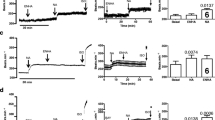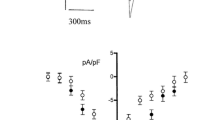Summary
Chronic β-adrenoceptor stimulation leads to desensitization of the myocardial adenylyl cyclase signalling pathway which includes β-adrenoceptor downregulation and upregulation of Gi-protein α-subunits. However, these investigations have mainly been done in cellular preparations. In this study we report that isoprenaline infusion in vivo leads to an increase in myocardial Gia and present evidence for functional consequences of this increase.
Rats were treated by a 4-day subcutaneous infusion with isoprenaline (2.4 mg/kg·d), propranolol (9.9 mg/kg·d) and triiodothyronine (T3, 0.5 mg/kg·d) for comparison. Isoprenaline treatment increased the pertussis toxin-sensitive amount of Gia by 22±6% and decreased β1- and β2-adrenoceptor density from 35±4 to 23±6 fmol/mg protein and 24±4 to 8±6 fmol/mg protein, respectively. Contraction experiments on electrically driven papillary muscles revealed that the negative inotropic potency of the M-cholinoceptor agonist carbachol in the presence of isoprenaline was increased as compared to control (mean EC50-values: 0.04 μmol/l vs. 0.28 μmol/l). All isoprenaline-induced effects were antagonized by simultaneously administered propranolol. T3 treatment had no influence on the parameters investigated.
The results suggest that chronic β-adrenoceptor stimulation desensitizes myocardial adenylyl cyclase by at least two mechanisms: β-adrenoceptor downregulation leading to diminished signal transduction in the stimulatory pathway and Giα upregulation leading to sensitization of the inhibitory pathway. Such adaptation might protect the heart from chronic exposure to catecholamines in heart diseases with elevated plasma catecholamine levels.
Similar content being viewed by others
References
Asano T, Semba R, Kamiya N, Ogasawara N, Kato K (1988) Go, a GTP-binding protein: immunochemical and immunohistological localization in the rat. J Neurochem 50:1164–1169
Böhm M, Gierschik P, Jakobs KH, Pieske B, Schnabel P, Ungerer M, Erdmann E (1990) Increase of Giα in human hearts with dilated but not ischemic cardiomyopathy. Circulation 82:1249–1265
Bradford MM (1976) A rapid and sensitive method for quantitation of microgram quantities of protein utilizing the principle of protein-dye binding. Anal Biochem 72:248–254
Bristow MR, Sandoval AB, Gilbert EM, Deisher T, Minobe W, Rasmussen R (1988) Myocardial α- and β-adrenergic receptors in heart failure: is cardiac-derived norepinephrine the regulatory signal? Eur Heart J 9 [Suppl H]:35–40
Bristow MR, Hershberger RE, Port JD, Gilbert EM, Sandoval A, Rasmussen R, Cates AE, Feldman AM (1990) β-adrenergic pathways in nonfailing and failing human ventricular myocardium. Circulation 82 [Suppl I]:12–25
Brodde O-E, Zerkowski H-R, Borst HG, Maier W, Michel MC (1989) Drug- and disease-induced changes of cardiac β1- and β2-adrenoceptors. Eur Heart J 10 [Suppl B]:38–44
Chang HY, Klein RM, Kunos G (1982) Selective desensitization of cardiac beta adrenoceptors by prolonged in vivo infusion of catecholamines in rats. J Pharmacol Exp Ther 221:784–789
Cohn JN, Levine TB, Olivari MT, Garberg V, Lura D, Francis GS, Simon AB, Rector T (1984) Plasma norepinephrine as guide to prognosis in patients with congestive heart failure. N Engl J Med 311:819–823
Daly PA, Sole MJ (1990) Myocardial catecholamines and the pathophysiology of heart failure. Circulation 82 [Supp I]:35–43
Eschenhagen T, Mende U, Nose M, Schmitz W, Scholz H, Warnholz A, Wüstel J-M (1991) Isoprenaline-induced increase in mRNA levels of inhibitory G-protein α-subunits in rat heart. Naunyn-Schmiedeberg's Arch Pharmacol 343:609–615
Feldman AM, Cates AE, Veazey WB, Hershberger RE, Bristow MR, Baughman KL, Baumgartner WA, Van Dop C (1988) Increase in the 40000-mol wt pertussis toxin substrate (G-protein) in the failing human heart. J Clin Invest 82:189–197
Hadcock JR, Malbon CC (1988) Down-regulation of β-adrenergic receptors: agonist-induced reduction in receptor mRNA levels. Proc Natl Acad Sci USA 85:5021–5025
Hadcock JR, Ros M, Watkins DC, Malbon CC (1990) Cross-regulation between G-protein-mediated pathways. J Biol Chem 265: 14784–14790
Hayes JS, Pollock GD, Fuller RW (1984) In vivo cardiovascular responses to isoproterenol, dopamine and tyramine after prolonged infusion of isoproterenol. J Pharmacol Exp Ther 231:633–639
Hayes JS, Wyss VL, Schenck KS, Cohen ML (1986) Effects of prolonged isoproterenol infusion on cardiac and vascular response to adrenoceptor agonists. J Pharmacol Exp Ther 237:757–763
Korth M, Kühlkamp V (1987) Muscarinic receptors mediate negative and positive inotropic effects in mammalian ventricular myocardium: differentiation by agonists. Br J Pharmacol 90:81–90
Laemmli UK (1970) Cleavage of structural proteins during assembly of the head of bacteriophage T4. Nature 227:680–685
Lu X, Barnett DB (1990) Differential rates of down regulation and recovery of rat myocardial β-adrenoceptor subtypes in vivo. Eur J Pharmacol 182:481–486
Malbon CC, Rapiejko PJ, Watkins DC (1988) Permissive hormone regulation of hormone-sensitive effector systems. Trends Pharmacol Sci 9:33–36
Marsh JD, Barry WH, Neer EJ, Alexander RW, Smith TW (1980) Desensitization of chick embryo ventricle to the physiological and biochemical effects of isoproterenol. Circ Res 47:493–501
Michel MC, Pingsmann A, Beckeringh JJ, Zerkowski H-R, Doetsch N, Brodde O-E (1988) Selective regulation of β1- and β2-adrenoceptors in the human heart by chronic β-adrenoceptor antagonist treatment Br J Pharmacol 94:685–692
Molenaar P, Smolich JJ, Russell FD, McMartin LR, Summers RJ (1990) Differential regulation of beta-1 and beta-2 adrenoceptors in guinea-pig atrioventricular conducting system after chronic (-)-isoproterenol infusion. J Pharmacol Exp Ther 255:393–400
Mumby S, Pang I-H, Gilman A, Sternweiss P (1988) Chromatographic resolution and immunologic identification of the α40 and α41 subunits of guanine nucleotide-binding regulatory proteins from bovine brain. J Biol Chem 263:2020–2026
Nanoff C, Freissmuth M, Tuisl E, Schütz W (1989) A different desensitization pattern of cardiac β-adrenoceptor subtypes by prolonged in vivo infusion of isoprenaline. J Cardiovasc Pharmacol 13:198–203
Neumann J, Schmitz W, Scholz H, von Meyerinck L, Döring V, Kalmár P (1988) Increase of myocardial Gi-proteins in human heart failure. Lancet 11:936–937
Ordway GA, Gambarana C, Frazer A (1988) Quantitative autoradiography of central beta adrenoceptor subtypes: comparison of the effects of chronic treatment with desipramine or centrally administered 1-isoproterenol. J Pharmacol Exp Ther 247:379–389
Reithmann C, Gierschik P, Sidiropoulos D, Werdan K, Jakobs KH (1989) Mechanism of noradrenaline-induced heterologous desensitization of adenylate cyclase stimulation in rat heart muscle cells: increase in the level of inhibitory G-protein α-subunits. Eur J Pharmacol 172:211–221
Reithmann C, Gierschik P, Müller Werdan K, Jakobs KH (1990) Pseudomonas exotoxin A prevents β-adrenoceptor-induced upregulation of Gi protein α-subunits and adenylate cyclase desensitization in rat heart muscle cells. Mol Pharmacol 37:631–638
Sanford CF, Griffin EE, Wildenthal (1978) Synthesis and degradation of myocardial protein during the development and regression of thyroxine-induced cardiac hypertrophy in rats. Circ Res 43:688–694
Scatchard G (1949) The attraction of proteins for small molecules and ions. Ann NY Acad Sci USA 51:660–672
Schmitz W, Scholz H, Erdmann E (1987) Effects of α- and β-adrenergic agonists, phosphodiesterase inhibitors and adenosine on isolated human heart muscle preparations. Trends Pharmacol Sci 8:447–450
Stanton HC, Brenner G, Mayfield ED (1969) Studies on isoproterenol-induced cardiomegaly in rats. Am Heart J 77:72–80
Steinkraus V, Nose M, Scholz H, Thormählen K (1989) Time course and extent of α1-adrenoceptor density changes in rat heart after β-adrenoceptor blockade. Br J Pharmacol 96:441–449
Tse J, Powell JR, Baste CA, Priest RE, Kuo JF (1979) Isoproterenol-induced cardiac hypertrophy: modifications in characteristics of β-adrenergic receptor, adenylate cyclase, and ventricular contraction. Endocrinology 105:246–255
Zimmer HG, Peffer H (1986) Metabolic aspects of the development of experimental cardiac hypertrophy. Bas Res Cardiol 81 [Suppl 1]: 127–137
Author information
Authors and Affiliations
Additional information
Send offprint requests to U. Mende at the above address
Parts of the results have been presented at the Wintertagung of the Deutsche Gesellschaft für Pharmakologie und Toxikologie in Hannover, 1990 (Mende et al., Naunyn-Schmiedebergs Arch Pharmacol 342 [Suppl]:R24). The work has been supported by the Deutsche Forschungsgemeinschaft
Rights and permissions
About this article
Cite this article
Mende, U., Eschenhagen, T., Geertz, B. et al. Isoprenaline-induced increase in the 40/41 kDa pertussis toxin substrates and functional consequences on contractile response in rat heart. Naunyn-Schmiedeberg's Arch Pharmacol 345, 44–50 (1992). https://doi.org/10.1007/BF00175468
Received:
Accepted:
Issue Date:
DOI: https://doi.org/10.1007/BF00175468




